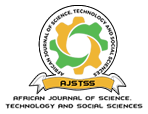The parametric analysis of sanitation technologies for Fecal Sludge Management:
a case of Eldoret Municipality, Uasin Gishu County, Kenya.
DOI:
https://doi.org/10.58506/ajstss.v2i2.198Keywords:
Sanitation TechnologiesAbstract
Sustainable sanitation is majorly focused on provision of safe, equitable and accessible sanitation for all irrespective of their gender, age and socio-economic status. This study aimed at the key parametric analysis of main sanitation technologies used and outlining urban fecal sludge management using a shit flow diagram. The Excreta flow diagram generated will be used as an advocacy tool for informing key sanitation stakeholders in the town on key parameters for sustainable fecal sludge management along the sanitation service chain. The key parameters focused on entailed the user interface, containment, conveyance, treatment and final disposal/reuse. Furthermore, the regulatory compliance monitoring, health and safety of sanitation provision were considered in the study. The study applied a mixed approach research design whereby qualitative and quantitative techniques were incorporated. Data collection process involved key informant interviews amongst sanitation workers and questionnaire guided interviews with the residents. Results unveiled that 64% of fecal sludge generated from Eldoret municipality was safely managed with 36% unsafely managed. Within the town, current coverage of existing sewer network (offsite sanitation) stands at 40% while 60 % actually rely on onsite sanitation. Study results further indicated a population of about 3% still practice open defecation. Comparing with high income areas, this study noted considerable coverage of sewer network within areas where low income communities occupied. Additionally, sanitation facilities were less accessible in these low income areas including Langas, Munyaka, Huruma and Mwanzo. There is dire concern on gender exclusivity of available sanitation facilities because of poor hygiene making it unsafe for use by women and children within the town. This study recommends increasing the coverage of sewer network in the town owing to higher water table in most areas around the town and its subsequent contribution to ground water contamination, and thus public health complication. In addition, this study recommends that regulatory authorities ought to oversee policies regarding safe fecal sludge disposal by improving access in order to reduce open defecation.


